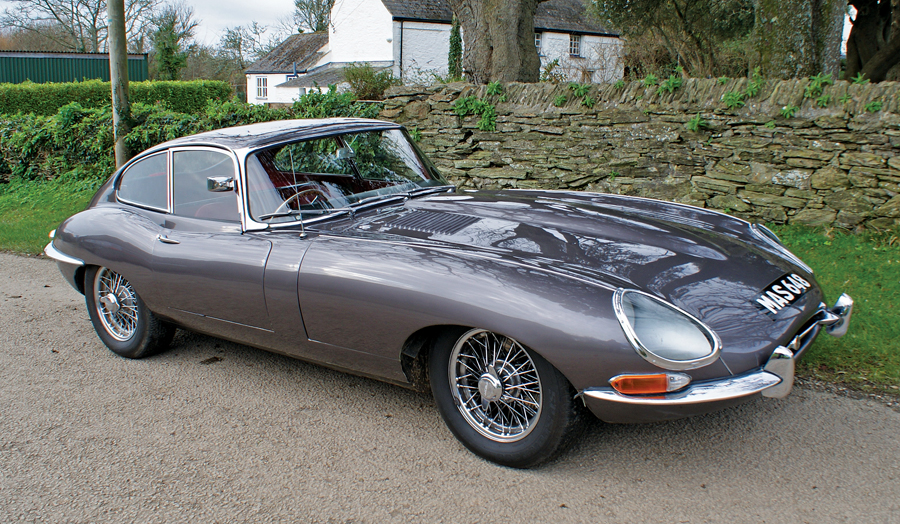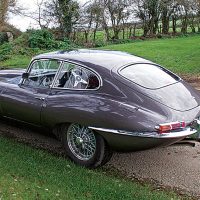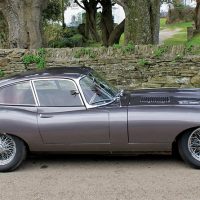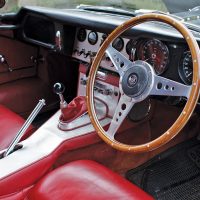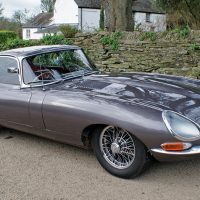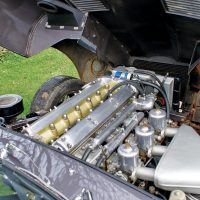SCM Analysis
Detailing
| Vehicle: | 1961 Jaguar E-Type 3.8 Flat-Floor Coupe |
| Years Produced: | 1961–62 |
| Number Produced: | 631 (all flat-floor E-type coupes) |
| Original List Price: | $5,895 |
| SCM Valuation: | $124,500 |
| Chassis Number Location: | Plate on “step” at front of right sill |
| Engine Number Location: | On rear face at front of cylinder head |
| Club Info: | Jaguar E-type Club, Tenbury Wells, Worcestershire, WR15 8LY, U.K. |
| Website: | http://www.e-typeclub.com |
| Alternatives: | 1958–63 Aston Martin DB4, 1963 Chevrolet Corvette Sting Ray, 1970–73 Datsun 240Z |
| Investment Grade: | B |
This car, Lot 15, sold for $150,317, including buyer’s premium, at Bonhams’ Goodwood Members’ Meeting sale in Chichester, U.K., on April 7, 2019.
I am the size of a younger Colin Chapman, but even I struggle to get into an E-type coupe with any grace.
When you’re wearing one they’re fab — Spitfire pilots would feel right at home, I suspect. But it’s the putting one on that can be a problem, as they’re a bit of a squeeze until you’re seated.
Beginning early in 1962, Jaguar addressed this by indenting the rear bulkhead to allow more seat travel — and creating floor pans that were sunken by about two inches, dropping the driver’s heels to create the impression of more legroom.
Nothing could be done about the shallow doors, which require you to feed in one leg at a time. I’ve no idea how ladies in short skirts manage. A gentleman generally finds something suddenly arresting on the horizon, but it’s something I shall look into one day.
About 2,000 E-types were built before the pans were extended, and it’s thought that only 631 of these were right-hand drive; just 175 are reckoned to have been coupes, of which this is the 28th, according to the chassis number 860028 (85 is a right-hand drive 3.8 roadster, 86 a right-hand-drive 3.8 coupe. Left-hand-drive 3.8 cars start at 87 and 88).
That’s out of about 72,500 E-types total.
Inevitably, given the elevation of rarity and exclusivity over sensibility and pragmatism in the collecting world, the result has been that the early cars with flat floors, even more so the first couple of hundred with the outside bonnet locks as well, are the most collectible — even though they are the hardest to live with.
Don’t get me started on Series I brakes. Or headlights. Seriously, if you want an E-type to drive instead of to pose with or lust over as an objet d’art, get a Series II. They’re cheaper, too.
Let’s not get into the coupe/roadster (sorry, Open Two Seater) debate. To my mind, the Series I coupe as Lyons and Sayer intended is the purest and most beautiful of the E-types, and the ragtop is an afterthought, though less so than the pregnant-looking 2+2.
The market says most people don’t agree, as roadster versions of anything attract up to a 100% price premium over the hard tops. In the case of Series I E-types, it’s only about 50%, which suggests there are a few folk on my side.
It WAS a flat-floor coupe
Anyway, this is a rare early flat-floor coupe. Except it isn’t.
Probably, and from an ergonomic point of view, wisely, the restorer elected to use later dropped floor pans when rebuilding the car in 2002. Hopefully that was done after talking with whoever owned it at the time.
Originality wasn’t quite as important 17 years ago as it is today, and there have been cars with one flat floor and one dropped pan, no doubt as a result of parts availability when they were stitched back together on the cheap and sent back out on the road.
This has over the years led to all sorts of anomalies such as Series I cars with Series II fronts, and vice versa.
This E-type was originally registered EMM 8 to Sir Eric Merton Miller, a property developer and financial supporter of then British Prime Minister Harold Wilson. Miller also owned a Ferrari Superfast bearing the same number, although it was never registered with the DVLA.
Sir Eric committed suicide in 1977 while under investigation for fraud. There’s a blank in this car’s history between then and when it was restored at The E-type Centre in 2002.
Given that the car has upgraded brakes and electrics, I suspect it was a conscious decision rather than a mistake to add a little more cockpit room, though in that case, why not just start with a later car?
Modifications to an original version of anything inevitably affect its value.
A fun driver — and easy to redo
A concours-grade, matching-numbers flat-floor coupe is around £150k–$175k (currently around $200k–$225k). Driver-quality Series I cars are $125k–$150k, which is where this sold — although it had been estimated at only £60k–£70k ($77k–$90k).
That’s Series II money, so it looks as if Bonhams was taking a pessimistic view on account of the various mods from standard. It sold better than a Series II — and slightly better than a ’62 coupe in the same condition. However, it does look as though most of the premium attracted by its early-car status has been lost along with the original floors.
I’d put this car on the cusp, value-wise. Quite well sold in its current state, it would be worth more with original-profile floors.
Either the buyer wasn’t too bothered about the finer details of accuracy, which are all under the skin — or she or he knew that putting the pans right will only cost a few grand. Alternatively, they could just enjoy their “flat floor” car as-is with its slightly roomier fit — it’ll be easier to get along with. ♦
(Introductory description courtesy of Bonhams.)
